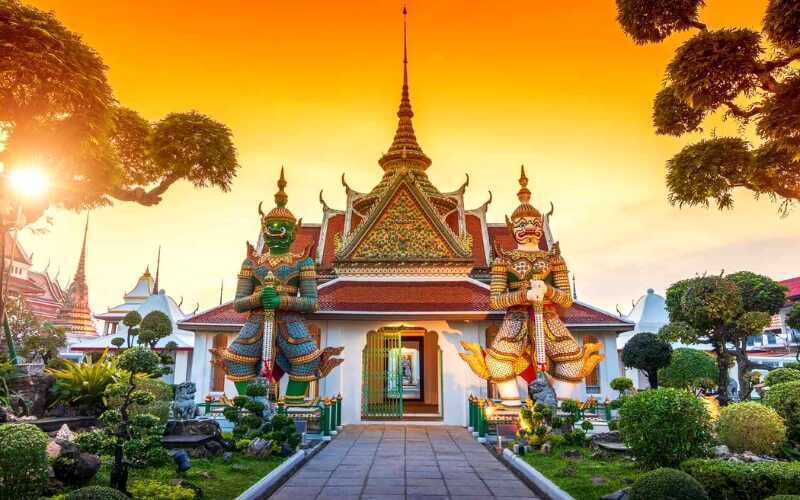
Chiang Mai is an extremely popular destination, attracting millions of visitors each year. One of the main attractions of the city is its stunning collection of temples in Chiang Mai. This is not surprising given that Chiang Mai was the capital of the Lanna kingdom for almost half a millennium. The ancient temples in Chiang Mai are some of the most breathtaking in Southeast Asia.
Tourists can marvel at a wide range of temples in Chiang Mai, from glistening Burmese-style structures to majestic golden-plated stupas. Some temples are in a state of disrepair, while others house enormous Buddha statues. They are located in diverse settings, including forests, waterfalls, and mountain slopes with breathtaking views. Regardless of which Chiang Mai temples you visit, you’re sure to be awed by their beauty and history.
Most Beautiful Temples in Chiang Mai
1. Most Famous Temple in Chiang Mai – Wat Phra Singh

Wat Phra Singh
Wat Phra Singh is the most visited temple in Chiang Mai due to its significant attraction in the Lion Buddha. This revered Buddha image, located in a small chapel at the back of the complex, next to the golden chedi, is considered the most important in the city. It dates back to 1345 when Chiang Mai was the capital of the flourishing Lanna Kingdom in Northern Thailand. The temple is conveniently located at the western end of the Old City, making it a popular stop on a Chiang Mai Temple Tour. It is also surrounded by some of the best and affordable accommodations in Chiang Mai.
Wat Phra Singh is remarkable not only for housing the Lion Buddha but also for its magnificent Lanna-style temple architecture. The golden chedi is particularly stunning and vibrant, representing the epitome of Northern Thai temple style. One peculiar feature that catches every visitor attention is a group of lifelike elderly monk models meditating in the main viharn, Lai Kham. At first glance, many people propose them to be real. Their intricate details, such as nose and ear hairs, cause second-guessing even up close. It is a bit eerie but intriguing nonetheless.
2. Wat Chedi Luang
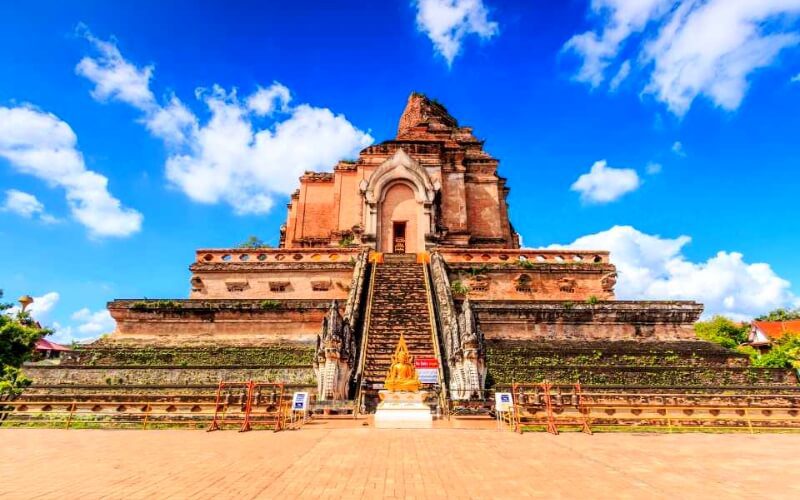
Wat Chedi Luang
Wat Chedi Luang is the second most visited temple in the Old City of Chiang Mai. It was once one of the tallest structures in the Lanna Kingdom and dates back to 1441. However, it suffered significant damage from an earthquake in 1545 and cannon fire when the city was retaken from the Burmese in 1775. The temple was home to the Phra Kaew (Emerald Buddha), Thailand’s most revered Buddha image, made of jade. However, it is now housed in the Grand Palace in Bangkok, and a replica has taken its place in one of the chedi’s alcoves.
Unlike other ancient temples in Chiang Mai that have undergone continuous renovation, Wat Chedi Luang’s massive damaged chedi appears as proper ruins, making it feel like the oldest. You will be particularly drawn to the stone nagas that flank the staircases on all four sides of the chedi.
Located in the heart of the Old City, Wat Chedi Luang is a short 5-10 minute walk east of Wat Phra Singh along Ratchadamnoen Rd. Turn right on Prapokkloa Rd. and continue past Wat Phan Tao to reach the temple entrance.
3. Wat Phan Tao
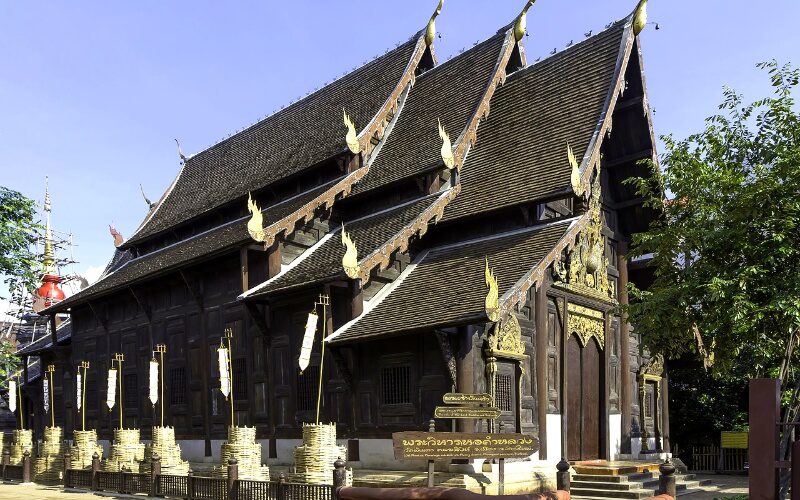
Wat Phan Tao
Wat Phan Tao is one of the older temples in Chiang Mai, with the first structures built in the late 14th century. Its name, meaning “temple of a thousand kilns,” is believed to have been derived from the ovens used to cast Buddha images for the adjacent Wat Chedi Luang temple. The viharn of Wat Phan Tao was originally a throne hall, built in 1846 for one of Chiang Mai’s kings. After a new king ascended the throne, the old palace hall was most likely demolished to make way for a new palace building, and the wooden panels were used to construct the viharn of Wat Phan Tao in 1876.
The all-wooden viharn is constructed from teak panels and has a stone base. It is one of the few remaining all-wooden structures of its kind in Chiang Mai, with a three-tiered roof adorned with stylized Naga snakes on its roof ends. The gilded pelmet over the entrance is particularly beautiful, with intricately carved Lanna flower motifs, and a gilded carving of a peacock over a crouching dog. Inside, the large red-painted teak pillars support the building, and there is also a big golden sitting Buddha opposite the entrance, which is the Wat Phan Tao’s principal Buddha image. Other interesting features inside the viharn include old wooden boxes decorated with gold leaf containing Buddhist scriptures written on palm leaves and an ornately carved wooden Ku, a Buddha throne used to enshrine important Buddha images.
4. Best Temple in Chiang Mai – Wat Chiang Man
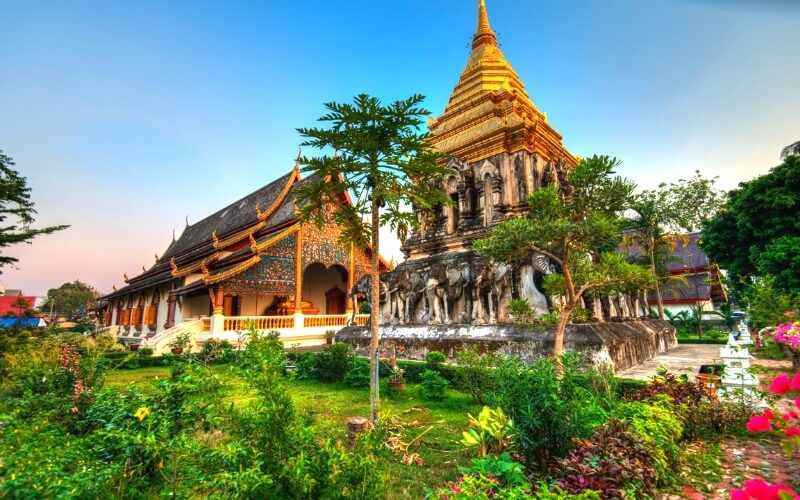
Wat Chiang Man
Wat Chiang Man, the oldest temple in Chiang Mai, dates back to the foundation of the city in 1296 by King Mengrai, who built the temple as the first one in the new city. It is home to several ancient and significant Buddha images.
The temple’s structures include the Chang Lom Chedi or Elephant Chedi, a Lanna and Singhalese style chedi that sits on a square base and is surrounded by 15 elephants emerging from the grey stone. The larger of the two Lanna-style viharns houses the oldest Buddha image in Chiang Mai, while the smaller one contains two small but crucial Buddha images and is guarded by mythical snake-like creatures called Nagas. The ubosot, or ordination hall, dates back to the 19th century and features beautifully carved wooden details in ochre colors on its front facade. The Ho Trai, or scripture library, is a small wooden building on top of a white stone base that protects the scriptures from flooding and pests.
Additionally, Wat Chiang Man is famous for the Phra Sila Buddha image, a bas relief stele that depicts a standing Buddha and is believed to have the power to bring rain. Another highly revered image is the Phra Sae Tang Khamani, a small Buddha image carved from quartz crystal, which is said to hold protective powers.
5. Wat U Mong Mahathera Chan
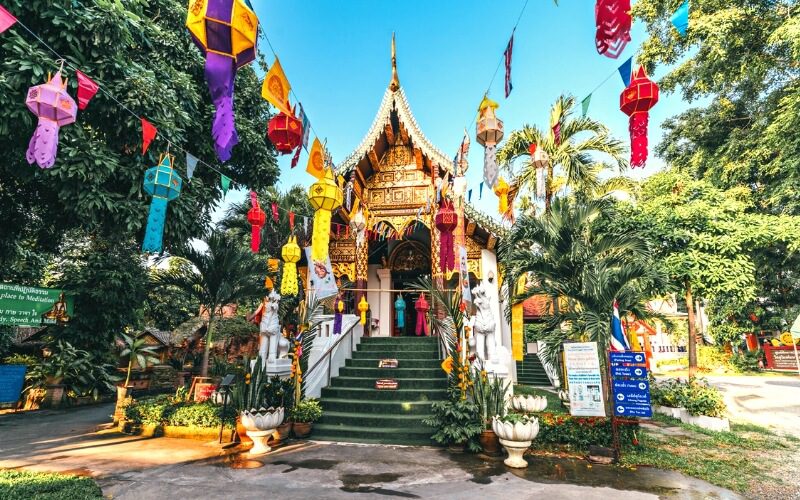
Wat U Mong Mahathera Chan
Nestled in the forest outside of the city lies Wat U Mong Mahathera Chan, also known as the “Tunnel Temple,” which sets itself apart from other Buddhist temples in Chiang Mai. This 13th century temple offers a peaceful and serene atmosphere away from the bustling crowds that often fill Chiang Mai’s more popular sites. Wat U Mong’s tunnels, containing shrines with Buddha images, provide a unique space for devotees to pay their respects to the Buddha. Its forested location with a natural lake also makes it an ideal place for meditation, where visitors can attend meditation classes and Dhamma talks at the meditation center.
According to a local legend, King Mengrai founded Wat U Mong after a monk named Thera Chan found it difficult to meditate in the city due to the noise and crowds. The King ordered a number of tunnels to be dug outside the city in a forested area bordering Doi Suthep mountain, lined with brick walls and plastered with Buddhist murals, giving Thera Chan a new place to meditate in peace and quiet.
This temple was abandoned during the 15th century but was restored in 1948 and reopened as a center for meditation and Buddhist teachings. Today, the ancient tunnels have been restored, and the temple houses resident monks. On the temple grounds is a large, circular bell-shaped chedi, a copy of an Ashoka pillar dating back to the temple’s founding, and a collection of damaged Buddha images.
6. Wat Inthakin
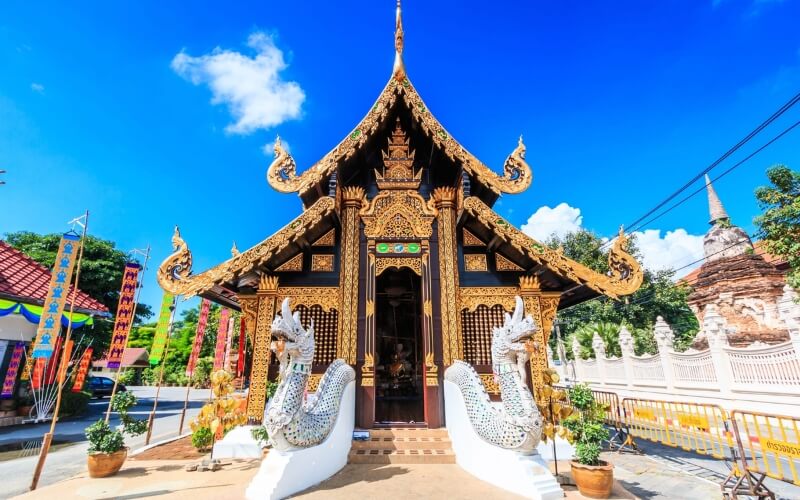
Wat Inthakin
The Wat Inthakin, also known as the Wat Sadue Muang, is a little-known temple located in the heart of the old walled town of Chiang Mai. It is made up of a small yet active viharn, two brick chedis, and the living quarters of the monks. Its name is derived from the Pali name for the Chiang Mai city pillar, Sao Inthakin, which means “pillar of Indra.” According to a local legend, the pillar was given to the people who inhabited the area by the Lord of Heaven in Hindu belief to protect them against evil.
Wat Inthakin was of great spiritual significance due to the presence of the city pillar. The temple’s founding date is uncertain, but it is known that King Mengrai of the Lanna Kingdom placed the pillar on the temple grounds in 1296. The temple’s viharn, or assembly hall, is a recently built ornate dark wooden building on a stone base. Inside the viharn houses the principal Buddha image named Luang Pho Khao.
7. Chiang Mai Temples – Wat Chiang Yuen
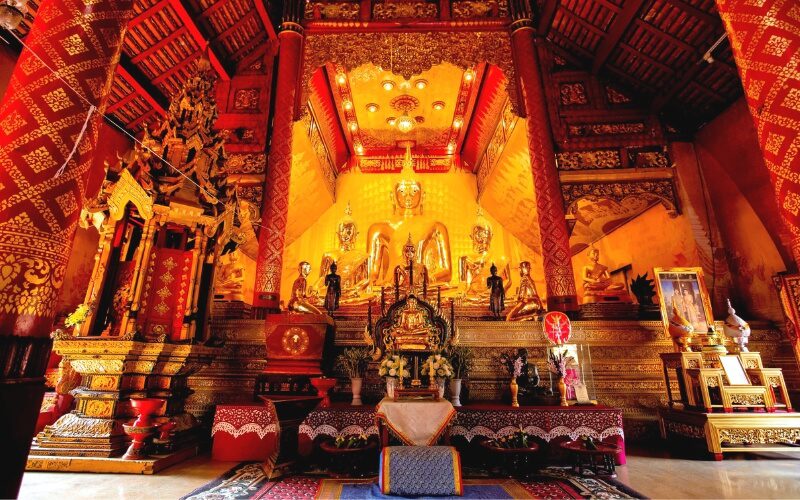
Wat Chiang Yuen
Wat Chiang Yuen, located just outside Chiang Mai city center, on Manee Nopparat Road, is not only famous for its ancient Burmese colonial gate and beautiful pavilion, but it also has several unique features. This temple played a vital role in the Lanna kingdom as every new king was mandated to pay his respects to the Phra Suppunyu Chao Buddha image here before being crowned. However, during the 18th century, when the Burmese conquered Chiang Mai, they abandoned the temple. It was then restored in 1794 after the Burmese were drove out.
The temple’s most distinctive feature is its chedi, a large white structure adorned with beautiful golden images. The base square of the chedi is decorated with gold and white chinthe, a lion commonly found in many Thai and Burmese temples, representing protection. According to ancient chronicles, important Buddha relics were kept inside the chedi during the reign of King Muang Kaeo in the 16th century.
The Lanna sala, located between the chedi and the viharn, is equipped with gold barge boards and ornate gables. The sala enshrines an image of Buddha and two intricately designed poles featuring a Hamsa bird, associated with the end of Samsara or the cycle of birth, death, and rebirth in Buddhism.
8. Wat Ku Tao
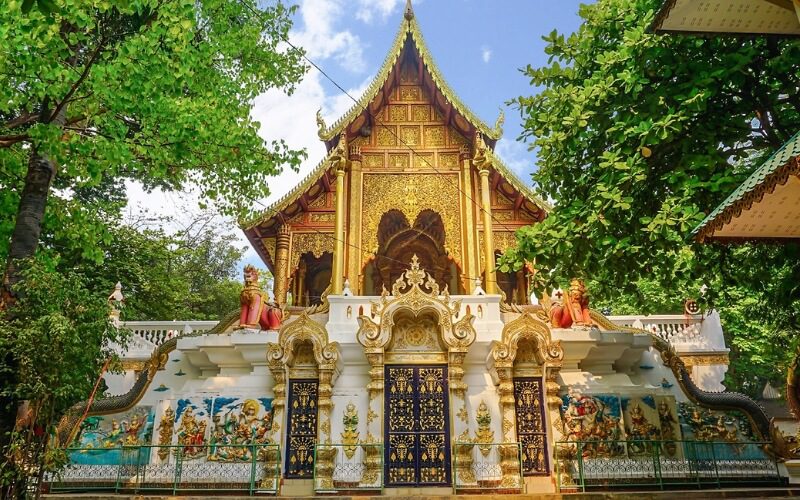
Wat Ku Tao
Surrounded by lush trees, Wat Ku Tao is one of the most tranquil temples in Chiang Mai. It is also call Wat Welu Wanaram due to the distinctive design of its chedi, which is said to resemble a tower of watermelons. The temple holds significant importance to the Shan people who largely originate from Burma.
Despite the relatively lengthy walk required to reach the temple, every visitor will be captivated by the serene and secluded atmosphere. The temple complex exudes an aura of peacefulness that makes you feel like you’re miles away from the city. The main assembly hall of the temple features exquisite goldwork and beautiful reliefs, which left a lasting impression on tourists go on Chiang Mai temple tour.
9. Wat Suan Dok
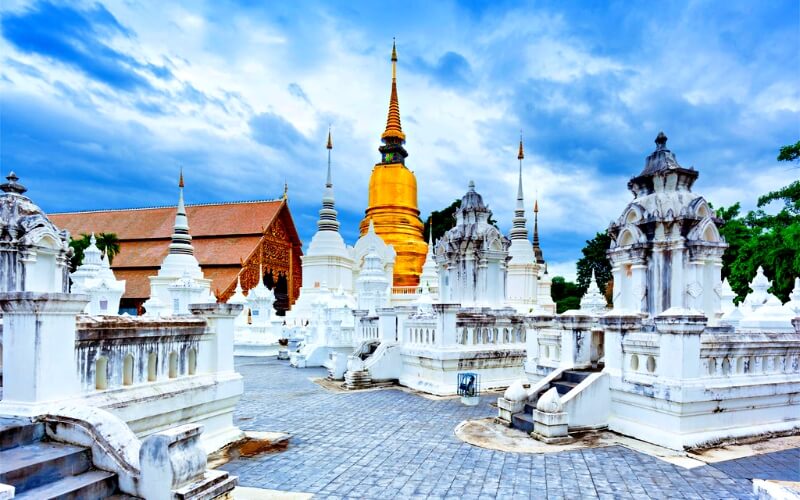
Wat Suan Dok
The Wat Suan Dok, located to the West of Chiang Mai’s old walled city, is a historic temple complex recognized for its many white chedis. The name Suan Dok translates to “flower garden temple,” deriving from the temple’s former function as a Royal flower garden. Constructed in the second half of the 14th century to enshrine a sacred Buddha relic, the Wat Suan Dok is famous for its 48-meter golden chedi, which contains the Buddha relic. The chedi is built-in Sri Lankan style and is the tallest structure in the temple complex. Along with the towering golden chedi, there are numerous small white chedis, which house the ashes of various members of the Chiang Mai Royal Family.
Besides its many chedis, the Wat Suan Dok also features a main assembly hall with stunning gold work and reliefs. According to the legend, when the monk Sumana Thera arrived in Chiang Mai with the Buddha’s relic, it magically split into two pieces. The smaller piece was enshrined in the Wat Suan Dok, while the larger piece was carried on a white elephant to the Doi Suthep mountain, where it died, and the Wat Phra That Doi Suthep was built in 1383.
10. Wat Mahawan
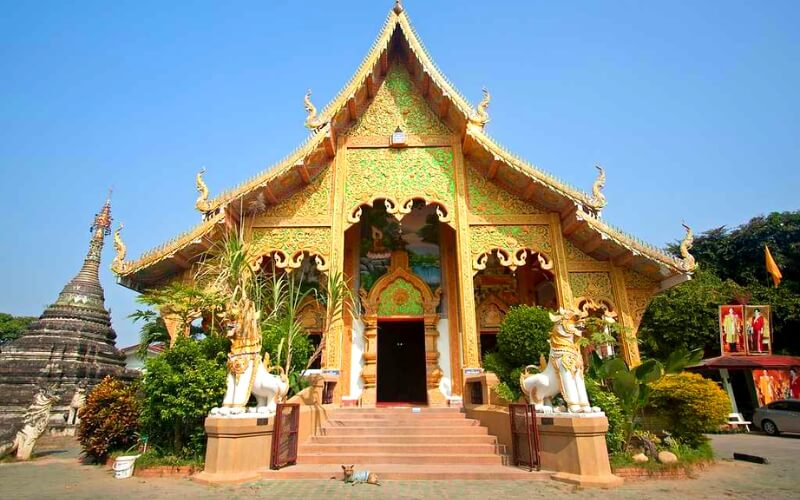
Wat Mahawan
Wat Mahawan is a beautiful temple located 200 meters east of the city wall, directly opposite Wat Chetawan. It consists of several buildings, including a spacious Lanna-style viharn on the northeast, a Burmese-style chedi to the west, an ornate ubosot (ordination hall) to the south, and a tall ho trai (library) to the southwest.
The Burmese-style chedi, with its wide flaring base and corner chinthe lions, was influenced by the Burmese teak merchants who patronized the temple in the late 19th and early 20th centuries. Despite the Burmese influences, the wooden buildings feature many local Lanna designs, including the ho trai, which seamlessly blends the two traditions. The open-air veranda, reminiscent of Burmese monasteries, wraps around all four sides of the ho trai building, which sits on a tall whitewashed masonry base. The gable pediment features a beautifully carved thewada guardian figure surrounded by floral motifs, accented with blue and gold glass fragments.
The viharn, built in 1865 and rebuilt in 1957, is of more traditional Lanna design and features an exuberantly decorated gable end inset with mirrored glass panels and teardrop-shaped glass inlay. The interior houses a single primary Buddha image seated at the west end in the Mara Vijaya posture. Certain elements of the viharn, such as its carved doors and elaborate stairway, are of fairly recent origin.
11. Wat Sri Suphan
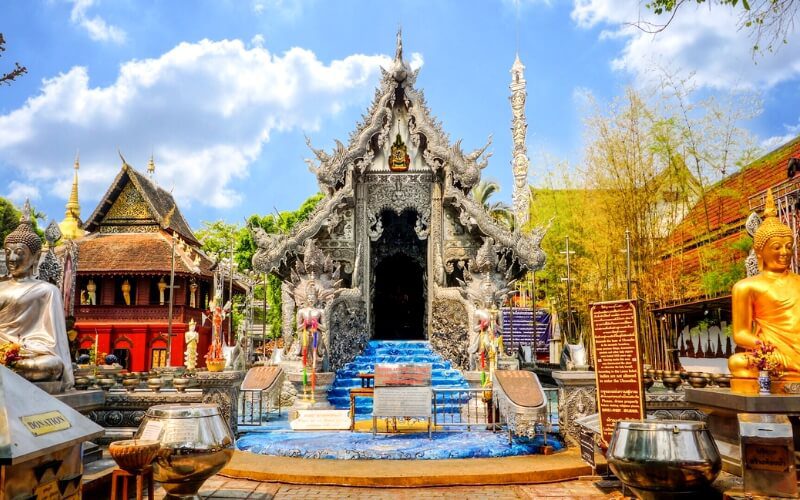
Wat Sri Suphan
The 500-year old temple Wat Sri Suphan is located in an area renowned for its skilled silversmiths. Its most famous feature is the silver ordination hall, a relatively recent addition adorned with a combination of silver, nickel, and aluminum. Additionally, the temple houses a silver and gold statue of Ganesh sheltered under a silver umbrella, a nod to Hinduism.
As one of the most unique Chiang Mai temples and conveniently situated next to the tourist-heavy Saturday Walking Street, it is among the city’s most frequented temples. In fact, it has earned a spot in the top 30 awe-inspiring Southeast Asian temples due to its rarity. The intricate detail in the metalwork also makes this temple exceptional. While the initial impression was impressive, upon closer inspection, the craftsmanship was truly remarkable.
It is worth noting that women are prohibited from entering the silver ordination hall due to long-standing tradition.
12. Best temple in Chiang Mai – Wat Phra That Doi Suthep

Wat Phra That Doi Suthep
Located on Doi Suthep mountain, Wat Phra That Doi Suthep is one of the most revered temples in Chiang Mai and holds great significance for its people. Established in 1383, it has undergone numerous expansions and renovations over the years, resulting in a grand display of holy shrines. Though located 15km away from the city center, the temple offers a breathtaking view of Chiang Mai city.
In 1935, followers of Monk Kruba Srivichai constructed a road leading up to the temple, making it more accessible to visitors. The mountain itself was declared a national park in 1981 and covers an area of 261 square kilometers, comprising of different forest types at varying elevations, including bamboo, mixed deciduous, dipterocarp, and evergreen forests. The park is also a part of the proposed Chiang Mai World Heritage Site project. With its cultural and natural significance, Wat Phra That Doi Suthep and the surrounding area are a must-visit destination during your trip to Thailand.
13. Wat Umong Suan Puthatham
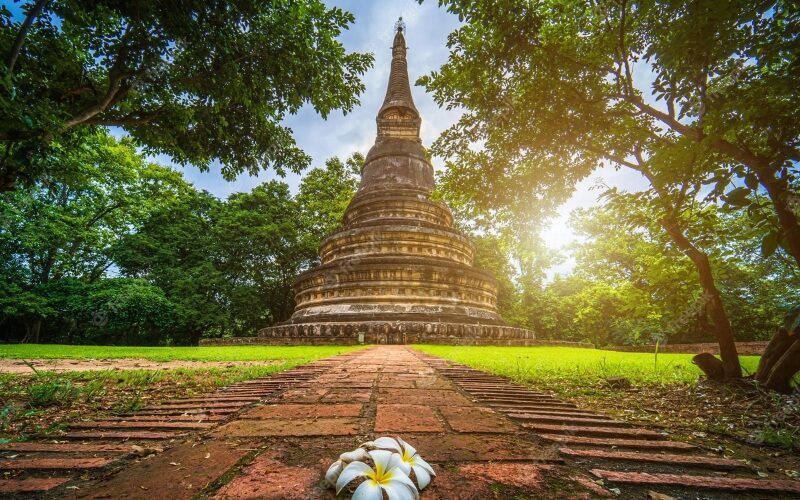
Wat Umong Suan Puthatham
Wat Umong Suan Puthatham is a striking example of a Thai forest temple that was originally constructed in the 14th century, abandoned, restored in the 1940s, and then re-established in the 1960s. Encompassing a vast area, the temple features a series of tunnels that lead to underground shrines situated below a large platform where the main chedi is located.
The tunnels at Wat Umong Suan Puthatham provide a surreal experience that is quite unlike any other temples in Chiang Mai, and you can spot various fascinating insects here. Moreover, if you continue along Soi U Mong to the south of the temple, this meandering and leafy road is home to several art galleries, farmer’s markets, and cafes. As one of the most trendy and up-and-coming neighborhoods in Chiang Mai, it is the perfect place to spend a few days, weeks, or even months if you have the luxury of time.
14. Wat Pha Lat
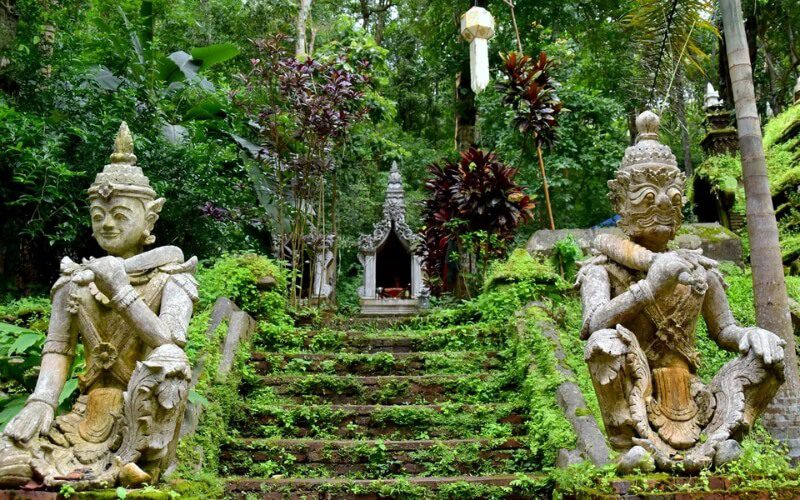
Wat Pha Lat
Wat Pha Lat, also known as the ‘monastery at the sloping rock,’ dates back to the reign of King Kuena in the 14th century. Legend has it that the king’s white elephant collapsed and died at the top of Doi Suthep mountain, prompting him to order the construction of four temples, including Wat Pha Lat, at the spots where the elephant had rested. In the 1930s, a Burmese businessman began restoring the temple after years of neglect. New temple buildings were constructed across the stream from the old ruins, showcasing the Burmese influence in their architecture and symbols.
While it was once an important resting place on the journey to Wat Doi Suthep, Wat Pha Lat is now a peaceful retreat primarily used as a monk’s residence and meditation center. It is nestled in the jungled slopes of Doi Suthep, half-hidden from the outside world. The main temple is particularly noteworthy for its Burmese-inspired design, adding to the unique character of the site.
15. Wat Phra That Doi Kham
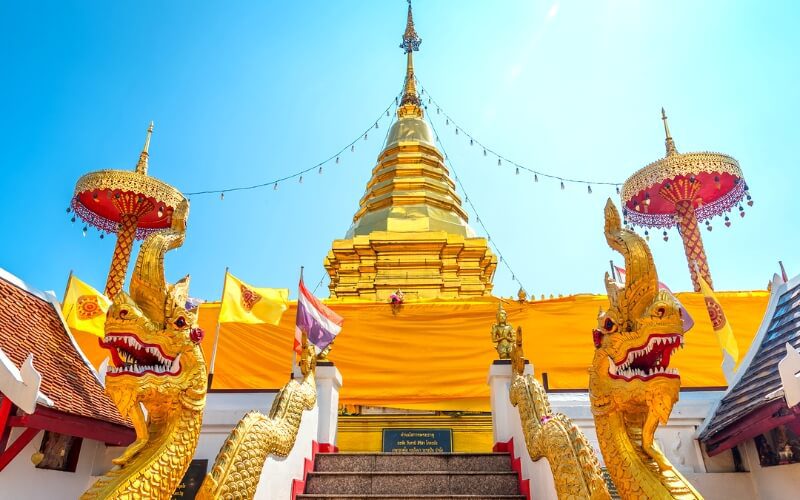
Wat Phra That Doi Kham
Located on a hill in the southwest of Chiang Mai city, Wat Phra That Doi Kham, also known as Doi Kham Pagoda or Golden Temple, is home to the oldest structure, a stupa built in 687, which houses a sacred relic of Buddha. A local legend tells of two giants who used to reside in the Doi Kham region and indulged in cannibalism. When Buddha visited the area, he persuaded them to stop their evil ways and converted them to Buddhism. He gave them a relic of his hair, which is now worshiped in the Stupa of the temple. When the Stupa collapsed in 1966, some Buddha images were discovered inside the damaged structure.
Apart from its religious significance, the temple is famous for its breathtaking panoramic view of the city and rolling mountains on the back of Mount Doi Pui. Tourists come here to admire the 17-meter-tall sitting Buddha statue, decorated in golden lent, which has earned the temple its nickname. Visitors can climb approximately 300 steps to reach the temple, or take an elevator for convenience. The staircase leading up to Wat Doi Kham is decorated with crafted snakes on each side, adding to the mystical ambiance of the place. The climb up is rewarding as it provides tourists with a stunning view of the mountains and the city.
Important Notes to Remember while Visiting Temples in Chiang Mai
Whether you practice Buddhism or not, you are always welcomed to visit temples in Chiang Mai. However, if you plan to visit such a sacred place, it is important to follow some rules of etiquette to ensure proper behaviors:
- Remove your shoes before entering a temple
- Take off hats and sunglasses
- Give the highest wai when greeting or saying goodbye to someone
- Do not turn your back to the Buddha, always face forward. Look but don’t touch them
- Don’t use your finger to point out at anything
- In some temples in Chiang Mai and Thailand, women are not allowed to visit parts or even the whole temple. Touching a monk or his robes is also completely off-limits to women.
- You are not compulsory but highly recommended to give a small amount of token of your appreation (about 20 Bahts) to the donation box in the temple you visit. Some temples in Chiang Mai provide shelter for children and your donation will benefit their life and education.
A visit to Chiang Mai temples is often combined with other tourist attractions in this north region of Thailand such as Doi Inthanon National Park, Mae Chaem, Mae Sariang, etc. Wondering how? You can refer to our 7 days Northern Thailand Discovery for a perfect guide on this trip.
Above is the list of 15 must-visit temples in Chiang Mai. Their unique architecture and peaceful atmosphere promise to satisfy every visitor, whether they are a believer of Buddhism or not. Interested in a visit to these unique temples, you can contact us for a tailor-made Chiang Mai temple tour of your preference.


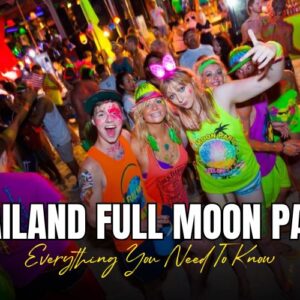


I visited the Wat Phra That Doi Suthep on my trip to Thailand last year. It is amazingly beautiful, actually a must-visit destination.